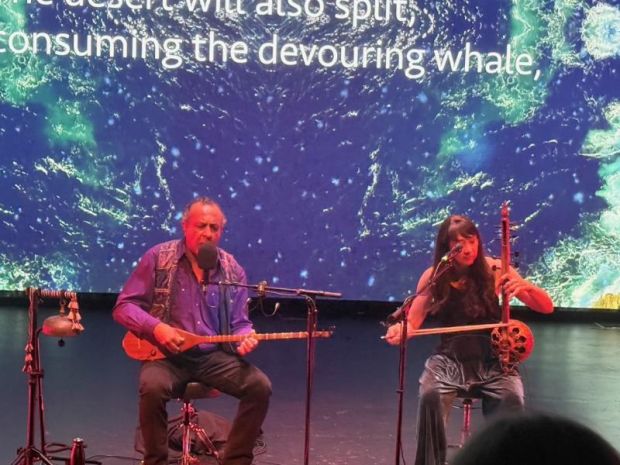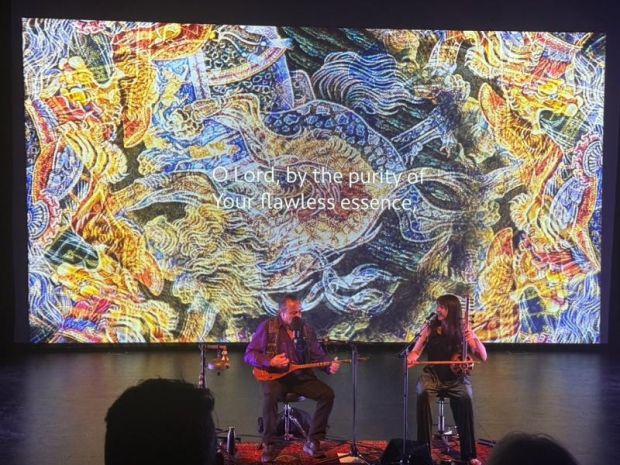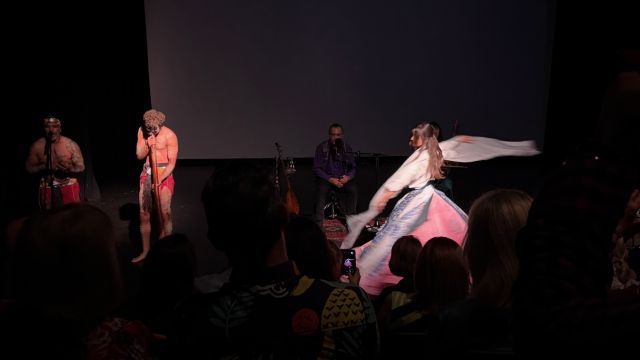Zemzemeh: Rhyme & Reason
In Zemzemeh: Rhyme & Reason, Persian Sufi mysticism met contemporary electronica, sacred poetry met sacred geometry, and the result was not so much a concert as a meticulously crafted, ceremonial act of transcendence. Presented by BEMAC, this work by the duo Zemzemeh (Siyavash Doostkhah and Greta Kelly) offered a rare and potent fusion of ancestral devotion and digital-age innovation, weaving together threads of music, poetry, visual art, and philosophy into a seamless spiritual fabric.
The performance distinguished itself from the outset through its extraordinary Welcome to Country. Performed by Gavin Tyson (vocals, clapsticks) and Rhys Monaghan (didgeridoo), it was not merely a formality but a profound exchange of knowledge. Tyson’s reflections on the traditional names of surrounding suburbs deepened the sense of connection to Country, setting a tone of reverence that carried through the entire performance. Their return in the finale, in collaboration with Zemzemeh and other guest artists, formed a moving act of cross-cultural ceremony which felt like an ethereal convergence of spirit.

The central duo’s musical dialogue was one of tension and harmony. Siyavash Doostkhah’s deep, resonant vocals and disciplined tanbour playing anchored the performance with gravitas and intention. His delivery carried the cadence of invocation that was commanding yet contemplative. In contrast, Greta Kelly’s vocals shimmered with warmth and fluidity, her shah kaman producing tones so organic they seemed to breathe. Together, they achieved a balance between masculine and feminine energy, ancient and modern, structure and surrender.
The sonic palette which was a carefully layered blend of traditional Persian instruments, hip-hop beats, synths, and samples, expanded the spiritual text into a universal language. The music did not attempt to modernise the ancient; rather, it invited the audience to inhabit it anew. The verses of Rumi, Hafez, and Attar were projected in translation alongside animated sacred geometry by Andrew Gibbs, illuminating the room both visually and emotionally. Gibbs’ live visuals were indispensable: astral patterns unfurled like the architecture of meditation itself, text flickered and dissolved in rhythm with the music, and the audience was invited into a contemplative state that bordered on trance.
Lighting by Lightology complemented the sonic and visual design with precision. Subtle gradations of light evoked a sense of timelessness. The production’s visual restraint served its thematic ambition: illumination, not spectacle. When Nadia Milford entered for the final Sama dance, the stage seemed to breathe with her movement. Her slow, circular turns—mirroring the geometry on screen—embodied the unity of body and spirit, grounding the abstract in physical grace.

What distinguished Rhyme & Reason from other hybrid performance works was its depth of philosophical integration. This was not fusion for novelty’s sake but fusion as revelation. Its structure mirrored the Sufi journey itself—an inward spiral from multiplicity toward oneness. One key theme was expressed beautifully in Alan Watts quote onscreen:
“Through our eyes, the universe is perceiving itself. Through our ears, the universe is listening to its harmonies. We are the witnesses through which the universe becomes conscious of its glory, of its magnificence.”
It was as if the work folded back upon itself in an act of self-awareness that positioned the audience as both witness and participant in the cosmic dialogue. The inclusion of a verse by Rumi whispered in 26 languages crystallised the show’s intent: the idea that diversity itself can be divine harmony.
Zemzemeh: Rhyme & Reason was not entertainment in any conventional sense. It was a meditation on perception, an invitation to presence, and a reminder that art, at its most courageous, can still serve as ritual. It is rare to encounter a performance that so elegantly unites intellectual rigour with spiritual depth, but Zemzemeh achieved precisely that; a post-digital dhikr for the modern soul.
Kitty Goodall
Photography by Kitty Goodall
Subscribe to our E-Newsletter, buy our latest print edition or find a Performing Arts book at Book Nook.

